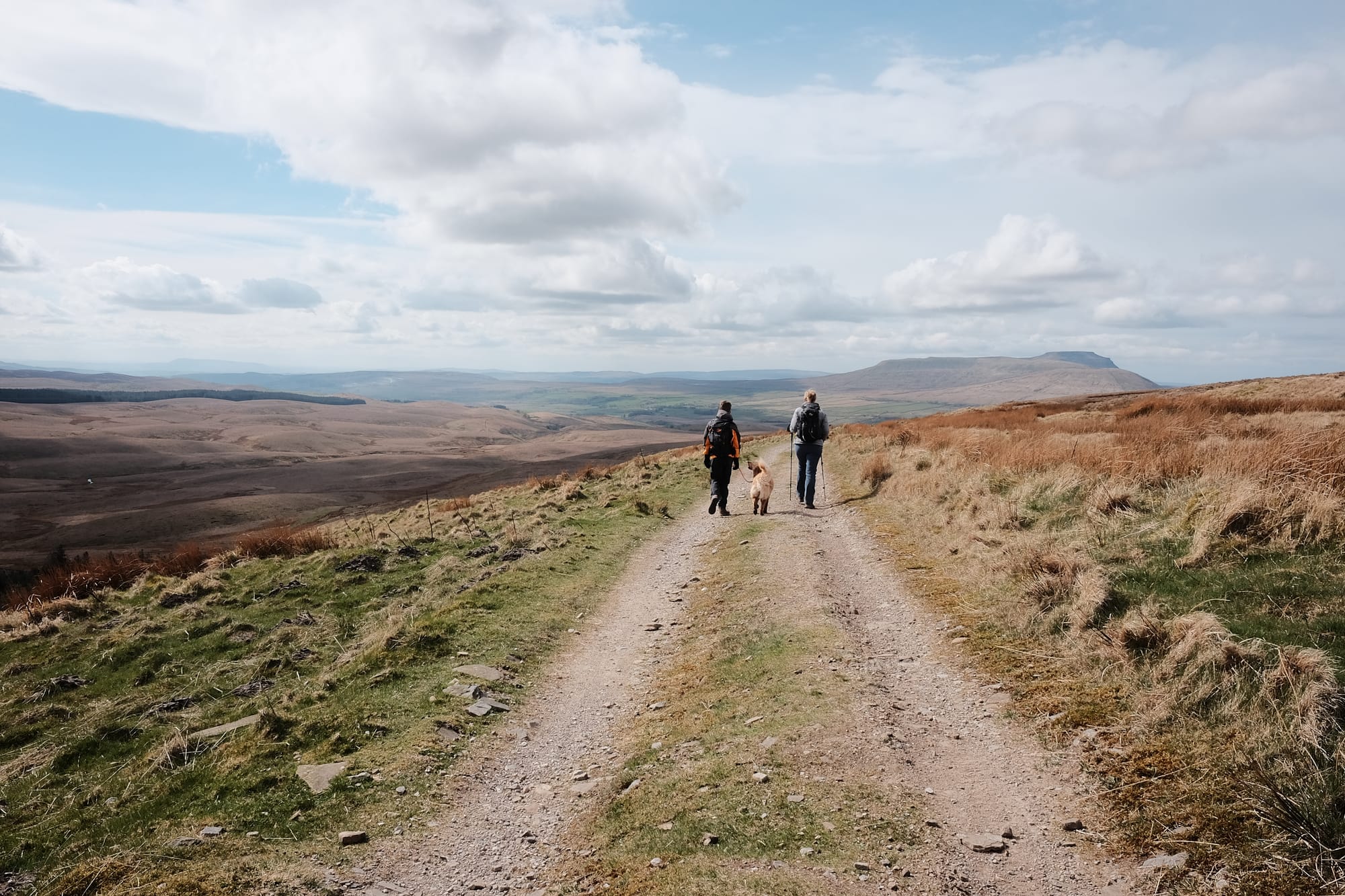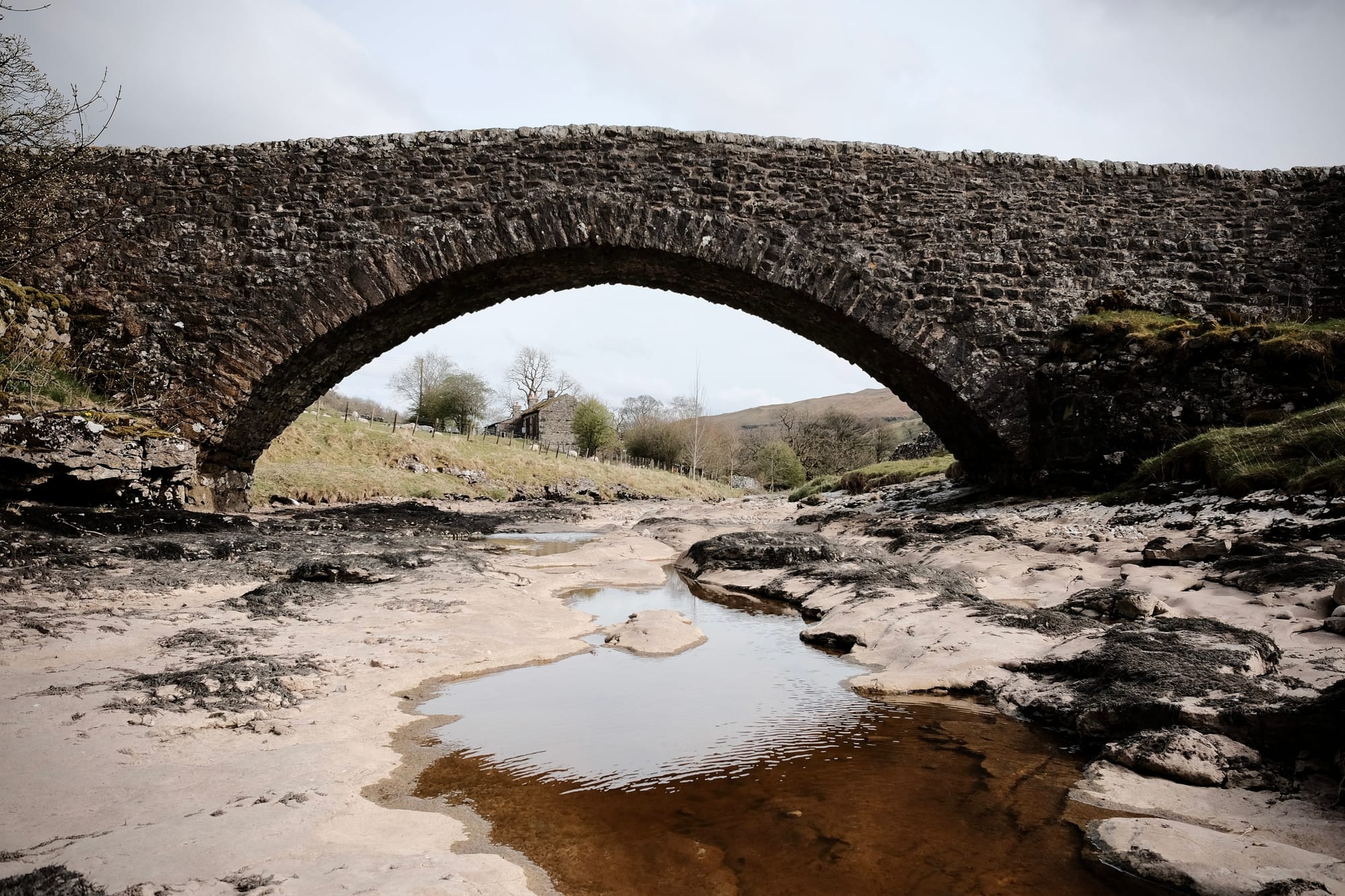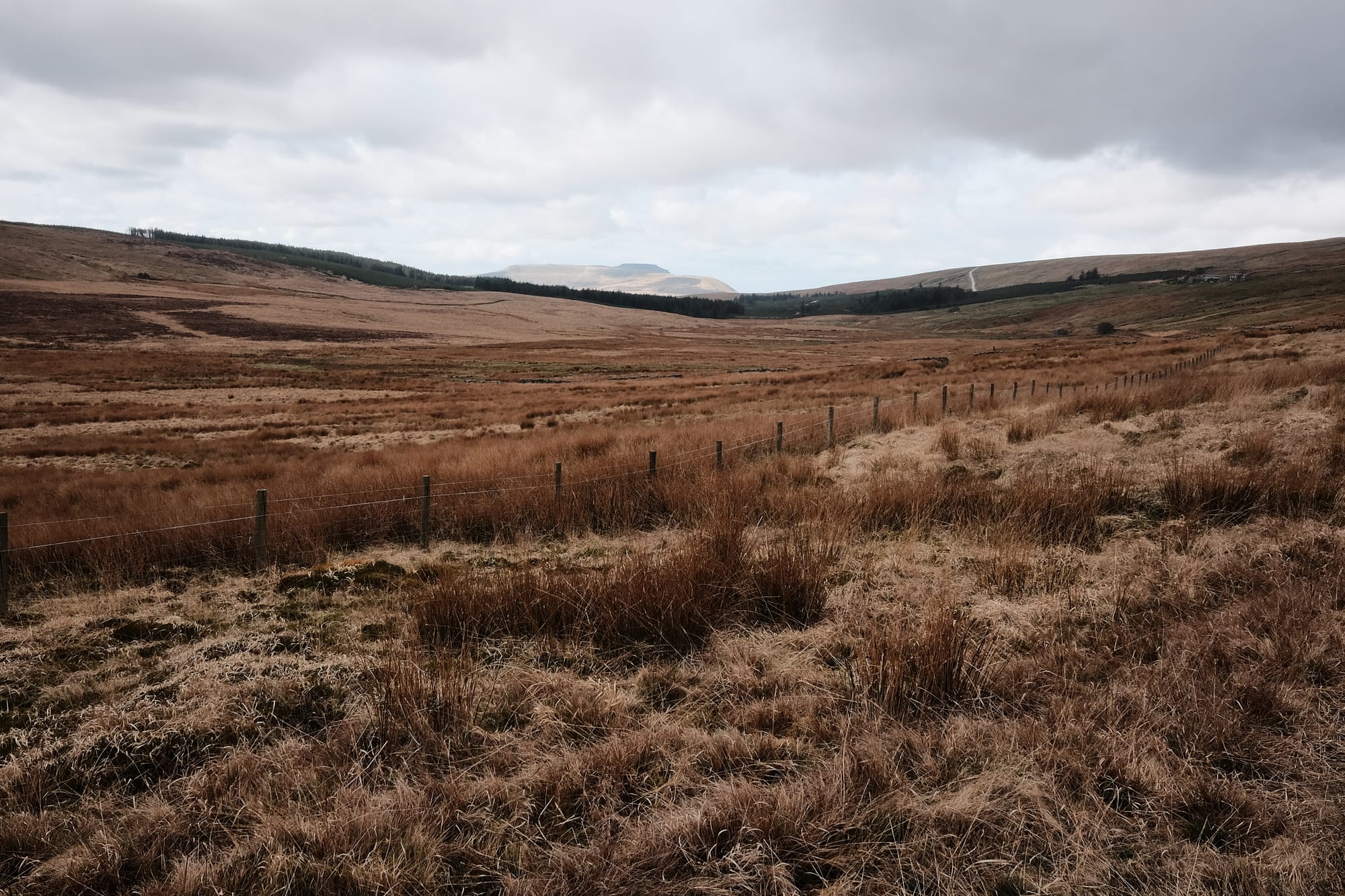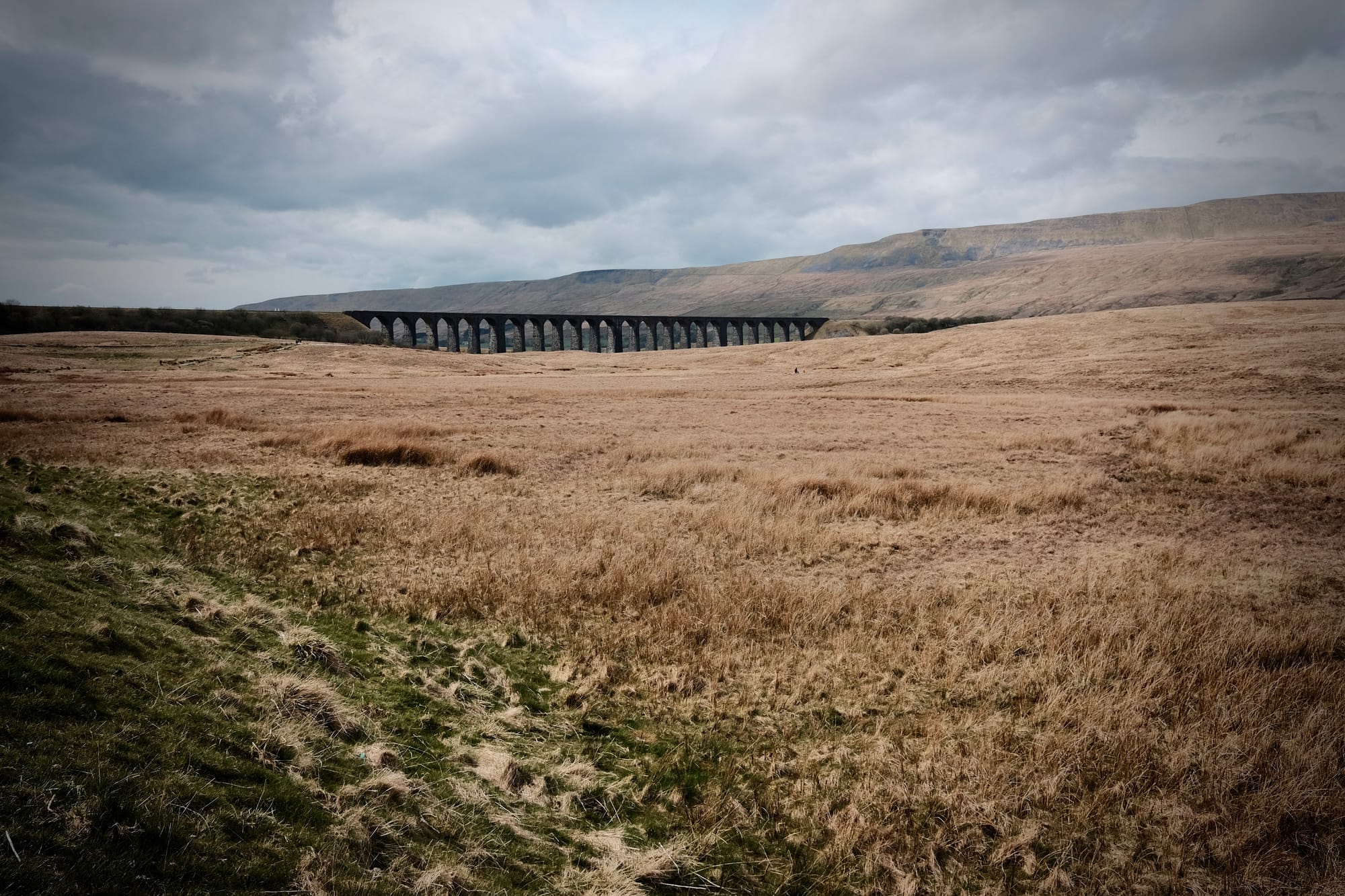Over Cam Fell
Walking through a parched yellow springtime, we left the River Wharfe's dry bed and crossed the high point of the Dales Way.

The 874 bus took us all the way from suburban Leeds to quaint Kettlewell, where we disembarked to begin the next stage of our family walk along the Dales Way. Our journey had cost the four of us – two adults, one child and one dog – just £7. For this, we had spent two hours trundling hypnotically along increasingly narrow lanes hemmed in by drystone walls. At one point near Bolton Abbey, the driver had to completely remove one wing mirror to squeeze his vehicle through a stone archway.
From Kettlewell, we were on foot. We eased our bus-stiffened legs into the rhythm of the path, ambling along the valley floor to the village of Buckden and a picnic lunch by the river. It was the last settlement of any size on our two-day route. We'd spend the rest of that day walking up the dale to stay overnight in the hamlet of Oughtershaw. The next day would take us over the high and wild Cam Fell before descending to Ribblehead and the train home.
By Yockenthwaite it was mid-afternoon, and the River Wharfe had run dry. Sparse March rains had starved the watercourse, and we climbed down and walked on its skeletal stone bed. Only the chill of the wind reminded us that this was spring, not late summer. England had received only a fraction of its usual rainfall and upland areas like this were tinder-dry. Climate change is making summer droughts more likely, but even so this seemed early.

At Beckermonds, we turned into Langstrothdale and followed what little remained of Oughtershaw Beck. Langstrothdale can be translated as 'long marsh' or 'marshy ground', but the soil under our feet was dry. Even our dog – a Golden Retriever who's an expert at finding mud – stayed unusually clean, aside from a covering of fine dust flicked up by her paws.
Before long, we were in Oughtershaw and knocking on the door of our accommodation – a perfect little bunkhouse attached to a converted Victorian school. Our host Louise and her husband bought the place after they saw it while walking the Dales Way. Now they run their own oasis in the hills for other weary walkers.
After dinner, as the light outside faded, I sat by the window to browse through the books and maps in the bunkhouse. One local history told the story of a wet summer in 1686, when the nearby village of Starbotton was struck by flash flooding.
In June of that year there was a terrible storm so that in a few minutes the becks were torrents running down the hillsides. An old account says that 'the rain lasted one and a half hours, the hill on one side opening, and casting up water to a prodigious height'.
Starbotton got the full force of it, and was almost swept away. Many cottages were knocked down, and those which survived were filled with stones and mud up to the first floor. Acres of land were covered with mud and gravel.
Around the UK, inundations like this are becoming more likely. Our changing climate is one of increasing extremes: droughts but also intense rainfall and flash flooding. Trees can help by slowing run-off, but the forests that seventh-century Anglians found when they settled in Langstrothdale have long been felled. Around Oughtershaw the Yorkshire Dales Rivers Trust is reinstating natural processes to help intercept, store and slow the movement of water across the landscape.
The next morning, well fed and rested, we set off towards Ribblehead and soon saw part of the flood management plan in action: belts of new saplings planted along the beck. Their distinctive green tree guards stood out against the tall, drought-yellowed grass. We'd found Oughtershaw much as the famous Dales vet and author James Herriot had, 'a piece of bleakest Yorkshire, but smiling in the sunshine through its bare miles of tufted grass'.

We did spot some mature trees amid the grass. At the far end of the dale there was a dark green patch of commercial forestry, with white stone roads threading through it like veins on a giant leaf. Every now and then a heavily laden lorry full of logs would wind itself up the steep track leading out of the plantation and across Cam Fell. Here it shared the old Roman road with the walkers on the Dales Way and Pennine Way before finally reaching the B road.
The plantation was Cam Forest, 240 hectares of Sitka spruce. Forty years ago, monocultures of non-native species such as Sitka were planted for profit across swathes of unsuitable upland areas. This thinking has now been consigned to the past, supplanted by an emphasis on mixed native species and varied types of habitat. But the trees that grew from it are now mature and ready for harvest.
The decision in 2013 to begin felling and extracting the timber along Cam High Road, as the Roman road is known, had been controversial. The Dales Way Association was strongly opposed to log lorries using Cam High Road. It pointed to other plantations in the UK where trees had been felled but then left to rot and create an insect-rich habitat, and to German national parks where horses and smaller vehicles were used to extract timber with less impact.
Colin Speakman – Chair, Dales Way Association, 2012
But the plantation's owners wanted their profit, and buyers were ready to pay for biomass pellets. So extraction began – just in Cam Forest at first, then in the neighbouring Greenfield Forest too. By the time we walked onto Cam High Road, 40-tonne log lorries had been rolling this way for 12 years. We stood aside as one passed us. The driver slowed his machine to a crawl, careful to avoid kicking up dust from the crushed white rock beneath its wheels.
The lorry picked up speed and disappeared towards Ribblehead. We followed, hypnotised by views of Yorkshire's three peaks: Pen-y-ghent, Ingleborough and Whernside. This was the high-point of the Dales Way. The route's end in the Lake District felt within reach, but that would have to wait for another trip. We'd finish this one by leaving the path and heading to Ribblehead railway station.

Ribblehead's giant viaduct pointed the way, and we learnt more about its history as we waited for our train. If we'd come this way in the early 1870s, we'd have seen a shanty town of construction workers. Around 3,000 navvies built the Midland Railway’s trunk route to Scotland through the Yorkshire Dales, of which the Ribblehead Viaduct is part. In total, the Settle-Carlisle line required 14 tunnels and 22 viaducts built over 72 miles of unforgiving terrain.
Navvies were expected to shift ten tonnes of material each day for little money, and many of them died in the process. Their deaths were often gruesome – run over by wagons laden with soil, blown up with dynamite. Ribblehead's bleak beauty is a reminder that someone always pays the price of progress.

